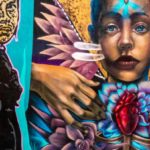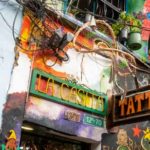A Picture is Worth a Thousand Words

Ron McGinty
Why go back to Bogota, Colombia twice in only a few months? My first tour guide was an enjoyable person and wore out my shoes, walking over 15,000 steps a day. Bogota is a large, lively, vibrant city. I assumed I saw it all. On
my last day, I asked about the street art, I was told it’s nothing and in a dangerous part of town.
For me, perilous could mean exciting, if careful. Hence, my second Bogota experience starts again for a week. I called the renown artist, Crisp (Christian
Petersen), in Bogota in advance. The wonders of cell service, he was actually in Australia. I wanted
the colors of world-famous graffiti to flare up in my mind. I needed an artist to be my tour guide,
and Crisp referred me to the artist, Bob.
 First, you need to know how Bogota became the graffiti nirvana. Painting on public spaces was illegal, and police were cracking down severely. Now, let us go back to 2011, where the story begins. A young teenager and flourishing painter one night finished his bold statement of social experiences in a mural. The next day, with the cold air and warm sun raising, he went back to sign it. The police chased him down and subsequently shot him in the back. The 16-year-old artist Diego Felipe Becerra, better known then as Tripido, died.
First, you need to know how Bogota became the graffiti nirvana. Painting on public spaces was illegal, and police were cracking down severely. Now, let us go back to 2011, where the story begins. A young teenager and flourishing painter one night finished his bold statement of social experiences in a mural. The next day, with the cold air and warm sun raising, he went back to sign it. The police chased him down and subsequently shot him in the back. The 16-year-old artist Diego Felipe Becerra, better known then as Tripido, died.
The outrage in the city was hyped and devastating, the two officers were arrested. Afterward, street
art was not legal but accepted with some rules of where. Fascinating, the city has commissioned a
few murals of their own. The epicenter is in the Candelaria area of Bogota, an old historic part of town. Here is the place all international backpackers and street people will gravitate to with its tattoo parlors, art supplies/smoke shops, and art galleries, etc.
 Almost all owners of warehouses in this zone decorate their properties with murals. Graffiti starts off as a means for the poor in communicating their voices and frustrations of politics and social issues. Today in Bogota artists come from all corners of the earth to leave their mark like Kike (Argentina), Ciclope (Argentina), Kiptoe (USA), and Ericailcane (Italy). In fact, Crisp is Australian and has painted all over the world. He settled in Bogota in 2011 and started Bogota Graffiti Tours.
Almost all owners of warehouses in this zone decorate their properties with murals. Graffiti starts off as a means for the poor in communicating their voices and frustrations of politics and social issues. Today in Bogota artists come from all corners of the earth to leave their mark like Kike (Argentina), Ciclope (Argentina), Kiptoe (USA), and Ericailcane (Italy). In fact, Crisp is Australian and has painted all over the world. He settled in Bogota in 2011 and started Bogota Graffiti Tours.
Graffiti goes all the way back to ancient Romans carving on street walls. It flourished in New York City, but more of bravura of vandalism on trains, buses, etc. As time progressed during the depression of the 1930s, the drug gangs to hiphop area graffiti became more of an art. Along came the spray paint can, which allows the artist to create large murals in just a matter of hours. Graffiti has stood the test of time, it exists all over the world. The young and underprivileged kids can have their day of fame and be recognized.
It seems obvious, but you have to go into a gallery to see the artwork, but outside walls are on display  for all God’s creatures to see. Study Picasso’s paintings and ask yourself if he was a graffiti artist? It is fun to study modern art because the price is made in the mind of the buyer. A Jean-Michel Basquiat painting became the first piece of art created after 1980 auctioned off at $110 million… pure creative and original graffiti! www.ronmcginty.com
for all God’s creatures to see. Study Picasso’s paintings and ask yourself if he was a graffiti artist? It is fun to study modern art because the price is made in the mind of the buyer. A Jean-Michel Basquiat painting became the first piece of art created after 1980 auctioned off at $110 million… pure creative and original graffiti! www.ronmcginty.com



Leave a Reply
Want to join the discussion?Feel free to contribute!